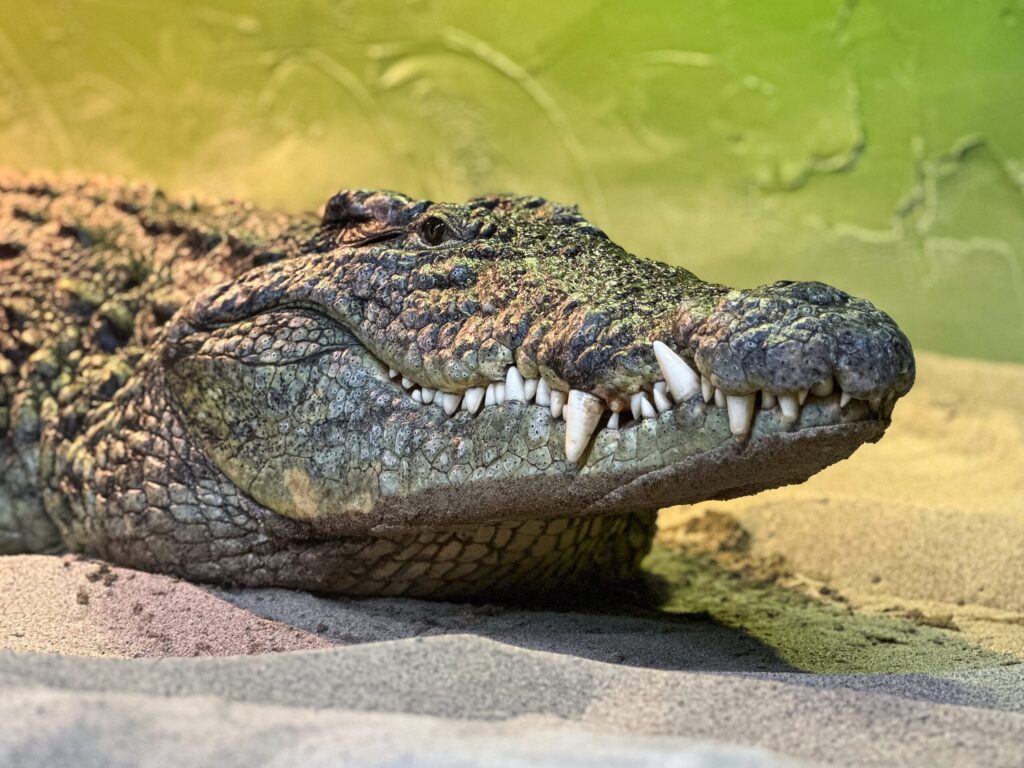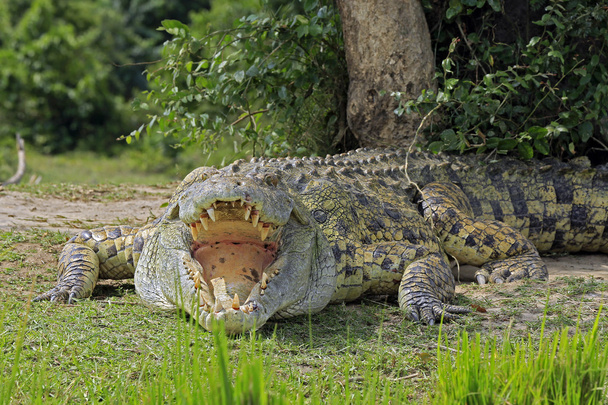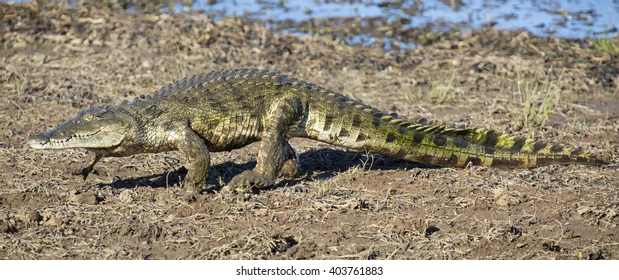Nile Crocodile Legal Protection
Nile Crocodile Legal Protection The Nile crocodile (Crocodylus niloticus), one of Africa’s most iconic reptiles, plays a vital role in its ecosystem. As apex predators, these formidable creatures help maintain the balance within their aquatic habitats. However, despite their ecological significance, Nile crocodiles face numerous threats, necessitating robust legal protection to ensure their survival. This article explores the need for legal protection of Nile crocodiles, the existing legal frameworks, and the ongoing conservation efforts that aim to safeguard this remarkable species.
Background on Nile Crocodiles
A. Description and Habitat

The Nile crocodile is a large reptile, capable of growing up to 20 feet in length. They inhabit a wide range of freshwater environments across Africa, including rivers, lakes, and wetlands. Their adaptability allows them to thrive in various habitats, from the dense swamps of the Okavango Delta to the Nile River itself.
B. Role in the Ecosystem
As apex predators, Nile crocodiles play a critical role in maintaining the health of their ecosystems. They help regulate the populations of fish and other aquatic species, preventing overpopulation and ensuring biodiversity. Additionally, crocodiles have cultural significance in many African communities, symbolizing strength and resilience.
Here’s a table summarizing key information about the legal protection of Nile crocodiles:
| Aspect | Details |
|---|---|
| Scientific Name | Crocodylus niloticus |
| Habitat | Freshwater environments (rivers, lakes, wetlands) across Africa |
| Role in Ecosystem | Apex predator, helps maintain ecological balance and biodiversity |
| Main Threats | – Habitat loss due to urban development and agriculture – Poaching and illegal trade – Human-crocodile conflicts |
| International Protection | Listed under CITES to regulate trade and ensure sustainable practices |
| National Laws | Various countries (e.g., Egypt, South Africa, Tanzania) have laws prohibiting hunting and trading |
| Conservation Efforts | – Establishment of protected areas – Community engagement and education programs |
| Successful Case Study | Nile Crocodile Conservation Project in South Africa |
| Challenges | – Insufficient funding for enforcement – Addressing local economic factors and misconceptions |
| Call to Action | Support conservation initiatives to protect Nile crocodiles and their habitats |
Feel free to modify or expand the table to include any additional information or specific details relevant to your article!
Threats to Nile Crocodiles
A. Habitat Loss and Degradation
Nile crocodiles face significant threats from habitat loss due to human encroachment, urban development, and agricultural expansion. Pollution from agricultural runoff and industrial waste further degrades their natural habitats, leading to a decline in crocodile populations.
B. Poaching and Illegal Trade

The demand for crocodile skin and meat has resulted in rampant poaching and illegal trade. This practice not only threatens the survival of Nile crocodiles but also disrupts the ecological balance. The illegal hunting of these reptiles has far-reaching consequences for both their populations and the ecosystems they inhabit.
C. Conflicts with Humans
Human-crocodile conflicts have become increasingly common as populations encroach upon crocodile habitats. Crocodiles are often perceived as threats to livestock and even human safety, leading to retaliatory killings. Misunderstandings and fear surrounding these creatures contribute to their decline.
Legal Framework for Protection
A. International Regulations
To combat the threats faced by Nile crocodiles, international regulations have been established. The Convention on International Trade in Endangered Species (CITES) plays a pivotal role in regulating the trade of crocodile products and ensuring sustainable practices. Nile crocodiles are listed under CITES, which provides a framework for monitoring and controlling international trade.
B. National Laws and Regulations

Many countries where Nile crocodiles are found have implemented national laws to protect them. For instance, Egypt, South Africa, and Tanzania have established regulations that prohibit hunting and trading of Nile crocodiles without proper permits. However, enforcement of these laws remains a significant challenge, often hindered by inadequate resources and corruption.
Conservation Efforts
A. Protected Areas and Wildlife Reserves
The establishment of protected areas and wildlife reserves is crucial for the conservation of Nile crocodiles. These designated habitats provide safe spaces for crocodiles to thrive, away from human encroachment. Success stories from regions like the Selous Game Reserve in Tanzania highlight the positive impact of protected areas on crocodile populations.
B. Community Engagement and Education
Engaging local communities in conservation efforts is vital for the success of legal protection. By educating communities about the ecological role of Nile crocodiles and promoting coexistence, conservation programs can reduce human-crocodile conflicts. Initiatives that involve locals in monitoring and protecting crocodile habitats can foster a sense of stewardship and ownership.
Case Studies
A. Successful Conservation Programs

Several successful conservation programs demonstrate the effectiveness of legal protection for Nile crocodiles. For example, the Nile Crocodile Conservation Project in South Africa has seen positive results through habitat restoration and community involvement. Collaborations between NGOs, governments, and local communities have led to increased awareness and improved management practices.
B. Ongoing Challenges and Areas for Improvement
Despite these successes, challenges remain. Funding and resources for enforcement are often insufficient, hindering the effectiveness of conservation laws. Additionally, addressing local concerns and economic factors that drive poaching and habitat destruction is essential for long-term sustainability.
Conclusion
The legal protection of Nile crocodiles is critical for their survival and the health of the ecosystems they inhabit. As threats to their populations continue to grow, it is imperative that governments, organizations, and communities work together to strengthen legal frameworks and conservation efforts. By supporting initiatives that protect Nile crocodiles, we can ensure a future where these magnificent creatures thrive in their natural habitats.
References
- CITES (Convention on International Trade in Endangered Species of Wild Fauna and Flora).
- National Geographic – Nile Crocodile Overview.
- IUCN Red List – Crocodylus niloticus.
- Wildlife Conservation Society – Nile Crocodile Conservation Projects.
Tips for Promoting Nile Crocodile Conservation
Educate Yourself and Others
- Learn about the ecological role of Nile crocodiles and the threats they face.
- Share information through social media, blogs, and community events to raise awareness.
Support Conservation Organizations
- Contribute to or volunteer with organizations dedicated to wildlife conservation and habitat protection.
- Look for local NGOs that focus on crocodile conservation efforts.
Advocate for Stronger Legal Protections
- Engage with policymakers to encourage the enforcement and creation of laws that protect Nile crocodiles.
- Participate in campaigns that promote wildlife protection laws and sustainable practices.
Promote Sustainable Practices
- Encourage sustainable tourism that respects wildlife habitats.
- Support businesses that prioritize ethical practices and conservation efforts in their operations.
Reduce Human-Crocodile Conflicts
- Educate communities living near crocodile habitats about safety measures and coexistence strategies.
- Advocate for community-led initiatives that address concerns while promoting crocodile conservation.
Participate in Citizen Science
- Join local conservation projects that involve monitoring crocodile populations and habitats.
- Report sightings and engage in data collection to contribute to research efforts.
Raise Awareness Through Art and Media
- Use creative outlets, such as photography, painting, or writing, to highlight the beauty and importance of Nile crocodiles.
- Share documentaries, articles, and educational videos to engage a wider audience.
Visit Protected Areas Responsibly
- If visiting habitats where Nile crocodiles reside, follow guidelines and respect wildlife by observing from a safe distance.
- Support eco-friendly tours that contribute to local conservation efforts.
Engage with Local Communities
- Collaborate with local communities to find solutions that benefit both people and crocodiles.
- Foster respect and understanding for the cultural significance of crocodiles in various communities.
Stay Informed About Conservation Issues
- Follow news related to Nile crocodiles and wildlife conservation efforts.
- Stay engaged in discussions about environmental policies and conservation challenges.
Here are some frequently asked questions (FAQs) about the legal protection of Nile crocodiles:
FAQs on Nile Crocodile Legal Protection
What is the legal status of Nile crocodiles?
Nile crocodiles (Crocodylus niloticus) are listed under CITES (Convention on International Trade in Endangered Species) and are protected by various national laws in countries where they are found. This means that international trade in Nile crocodiles and their products is regulated to prevent over-exploitation.
Why are Nile crocodiles endangered?
Nile crocodiles face numerous threats, including habitat loss due to urban development and agriculture, poaching for their skin and meat, and human-crocodile conflicts. These factors have contributed to declines in their populations.
How do legal protections help Nile crocodiles?
Legal protections create a framework for managing and conserving Nile crocodile populations. They help regulate hunting, protect habitats, and ensure that trade in crocodile products is sustainable. Enforcement of these laws can deter poaching and illegal trade.
What can I do to help protect Nile crocodiles?
You can help by educating yourself and others about Nile crocodiles, supporting conservation organizations, advocating for stronger legal protections, and promoting sustainable practices. Engaging with local communities and participating in conservation projects are also valuable contributions.
Are there successful conservation programs for Nile crocodiles?
Yes, there are successful conservation programs in various countries. For example, the Nile Crocodile Conservation Project in South Africa has seen positive results through habitat restoration, community involvement, and educational outreach.
How do human-crocodile conflicts occur?
Human-crocodile conflicts typically arise when crocodiles prey on livestock or pose threats to human safety. Misunderstandings and fear often lead to retaliatory killings of crocodiles, further threatening their populations.
What is the role of local communities in crocodile conservation?
Local communities play a crucial role in crocodile conservation. Engaging them in conservation efforts can help reduce conflicts and promote coexistence. Education and awareness programs can foster respect for crocodiles and their ecological importance.
What are the challenges in enforcing legal protections for Nile crocodiles?
Challenges include insufficient funding for enforcement, lack of resources, corruption, and the need to address local economic concerns that drive poaching and habitat destruction. Building community trust and cooperation is essential for effective enforcement.
How can tourism contribute to crocodile conservation?
Responsible ecotourism can provide financial incentives for local communities to protect crocodile habitats. It can create awareness about the importance of Nile crocodiles and generate funds for conservation efforts while promoting sustainable practices.
Where can I find more information about Nile crocodile conservation?
Reliable sources of information include wildlife conservation organizations, government wildlife agencies, academic research articles, and reputable websites dedicated to biodiversity and conservation. Engaging with community-led initiatives can also provide insights into local conservation efforts.
These FAQs provide a clear understanding of the legal protection of Nile crocodiles and the importance of conservation efforts. Feel free to add or modify any questions to better suit your audience!
